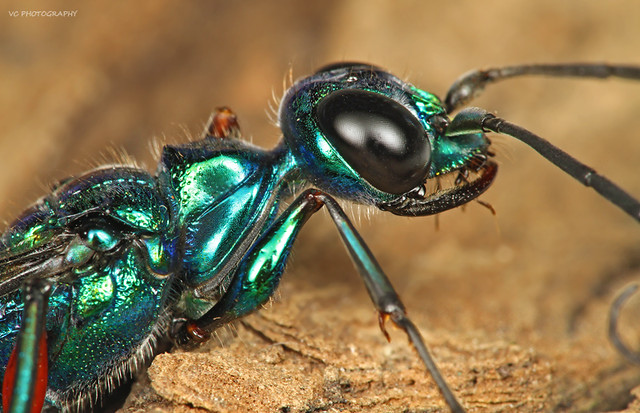This Halloween week I would like to highlight some scary insects for you. While I normally endorse bugs and try to get people to not look upon them with fear and loathing, it doesn’t mean that all insects are cuddly, wuddly woolyworms. Some can capture our greatest fears and make them real. Such as today’s scary bug, the emerald cockroach wasp…
What scares you the most? A bump in the night? That shadow off in the dark corner that slithers? Nicolas Cage movies?
| Via: http://commons.wikimedia.org/wiki/File:Emerald_Cockroach_Wasp.JPG |
What scares you the most? A bump in the night? That shadow off in the dark corner that slithers? Nicolas Cage movies?
Or, perhaps it’s a loss of control? Not just life events
spinning hopelessly out of your hands but a literal loss of control over your
body and its functions. Like an old voodoo zombie you would be alive but
incapable of self-functioning. It just so happens we have an insect that can
highlight this particularly terrifying circumstance.
The emerald cockroach wasp is a parasitoid insect. While
that sounds similar to parasite, they are actually very different life styles. A
parasite normally doesn’t result in the death of its host, sure accidents
happen, but by and large that would be a bad thing for something like a flea.
Parasitoids though, they kill. In fact, they often do so in imaginative ways that
would even make horror film masters blanch.
 |
| Stunning and maniacal! via:https://www.flickr.com/photos/cscvictor/5855698853/ |
For the emerald cockroach wasp this process is completed when a
female wasp finds a suitable cockroach host to inject one of her precious
eggs into. The wasp isn't as large as a cockroach but, lucky for her there are tools more effective than size at her disposal. When the wasp first attacks the cockroach, the roach
predictably fights back. During this struggle the wasp will inject her stinger
and venom into the thoracic ganglion (one of the cockroach's brains) ultimately
resulting in temporary paralysis of the front legs. Following this the wasp
expertly delves her stinger into the head. Using special sensory organs at the tip of her stinger she finds a spot in the roach’s main brain and injects it with venom.
This debilitates the roach’s escape reflex and sets the roach into a grooming
frenzy. While the now hapless cockroach stays in one spot grooming, the female wasp flies
off to find a suitable nesting hole.
 |
| Moving will only make it worse Images: Ram Gal |
Upon her return she will chomp down and bite the ends of the
roach’s antennae off. She then imbibes some cockroach blood (hemolymph),
casually you know, because zombie making is thirsty work. She can’t carry the roach so she simply leads it to her selected burrow by the
amputated antennae. Upon arrival, she lays an egg on the victim's leg then
entombs it in the hole by sealing the entrance off with pebbles.
Down there in the dark, the egg hatches after about three days. All the roach can do during this time is stand there and wait for the end. The baby wasp crawls from the leg and chews a hole in the cockroach’s abdomen and then slurps up the hemolymph that oozes out. After a few days of this it will burrow inside. Once comfy in its roach playpen, baby wasp proceeds to eat the internal organs. She does this carefully though, selectively eating the least important organs first before finishing up with the central nervous system. Thus, the cockroach is finally allowed the sweet release of death. Baby wasp then releases a sanitizing compound to get that fresh carcass smell, and pupates inside the roach husk. After about a month it chews its way out to start the horrifying process all over again…
Down there in the dark, the egg hatches after about three days. All the roach can do during this time is stand there and wait for the end. The baby wasp crawls from the leg and chews a hole in the cockroach’s abdomen and then slurps up the hemolymph that oozes out. After a few days of this it will burrow inside. Once comfy in its roach playpen, baby wasp proceeds to eat the internal organs. She does this carefully though, selectively eating the least important organs first before finishing up with the central nervous system. Thus, the cockroach is finally allowed the sweet release of death. Baby wasp then releases a sanitizing compound to get that fresh carcass smell, and pupates inside the roach husk. After about a month it chews its way out to start the horrifying process all over again…
 |
| Here's Johnny! Images: Ram Gal |
Join us tomorrow for another terror inducing post as we cast our gaze towards Japan and marvel at the madness that is a Japanese giant hornet!
Sources:
http://www.wired.com/2014/02/absurd-creature-of-the-week-jewel-wasp/
http://phenomena.nationalgeographic.com/2013/01/07/if-youre-going-to-live-inside-a-zombie-keep-it-clean/
Sources:
http://www.wired.com/2014/02/absurd-creature-of-the-week-jewel-wasp/
http://phenomena.nationalgeographic.com/2013/01/07/if-youre-going-to-live-inside-a-zombie-keep-it-clean/
